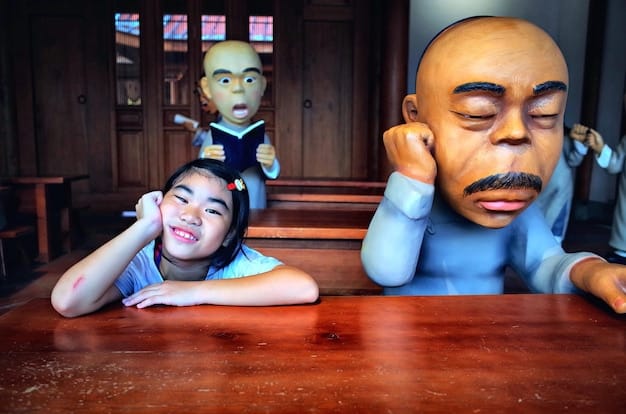Korean Drama Plot Twists: Predict the Unpredictable in K-Series

Korean drama plot twists captivate audiences with unexpected turns, dramatic reveals, and emotional cliffhangers, making it difficult to predict the storylines of upcoming series and enhancing viewer engagement.
The allure of Korean dramas, or K-dramas, lies not only in their compelling narratives but also in their ability to deliver unexpected twists that leave viewers on the edge of their seats. Predicting the unpredictable is part of the fun, as we anticipate the shocking revelations and emotional turns that make these series so addictive. Let’s dive into the world of Korean drama plot twists, exploring what makes them so effective and attempting to foresee the surprises in upcoming series.
The Art of the K-Drama Plot Twist
K-dramas have mastered the art of keeping audiences guessing. A well-executed plot twist can elevate a series from good to unforgettable. These twists often challenge our expectations, subvert established tropes, and add layers of depth to the characters and storylines.
Understanding what makes these twists so potent can help us appreciate them more deeply. The impact of a great plot twist stems from careful storytelling, character development, and the element of surprise.
Common Types of Plot Twists in K-Dramas
Plot twists in K-dramas come in various forms, each designed to elicit a specific emotional response from the audience. From shocking reveals to subtle betrayals, these elements keep us invested.
- Identity Reveals: Characters are not who they seem, leading to dramatic confrontations and emotional turmoil.
- Hidden Connections: Seemingly unrelated characters are revealed to have deep-rooted connections, altering the entire storyline.
- Flashbacks: Revealing past events that shed light on present-day conflicts and character motivations.
- Near-Death Experiences: Characters survive seemingly fatal incidents, often returning with new perspectives or altered identities.

By understanding these common types, viewers can become more attuned to the subtle clues and foreshadowing that K-drama writers often employ. This, in turn, heightens the anticipation and enjoyment of the viewing experience.
Analyzing the Success of Past K-Drama Twists
Some K-drama plot twists are legendary, leaving an indelible mark on the genre. Examining these iconic moments provides insight into what makes a twist truly effective.
Successful twists often hinge on emotional resonance, logical consistency, and the element of surprise. They should enhance the story, not detract from it.
Spoiler Alert: Memorable Twists from Popular Series
Before diving in, be aware that the following contains spoilers for some popular K-dramas. If you haven’t seen these series, you might want to proceed with caution.
- “Sky Castle”: The unexpected death of a main character shook the audience and set the stage for a dark exploration of societal pressures.
- “Reply 1988”: The mystery of who Deok-sun would marry kept viewers guessing until the very end, with subtle clues and misdirection adding to the suspense.
- “Penthouse”: The constant betrayals and shocking reveals in this series created a rollercoaster of emotions, making it a guilty pleasure for many.
- “Goblin”: The revelation of the Goblin’s past and the connection to the Grim Reaper added a layer of depth and tragedy to the romantic storyline.
These examples demonstrate the power of a well-executed plot twist to elevate a K-drama, making it a topic of discussion and a memorable viewing experience.

Predicting Twists in Upcoming K-Dramas: What to Look For
While predicting the future is impossible, we can analyze trends and recurring themes in K-dramas to anticipate potential plot twists in upcoming series.
Looking for specific narrative patterns and character archetypes can provide clues about where the story might be headed. Identifying these patterns can make the viewing experience more engaging.
Recurring Themes and Tropes to Watch
Certain themes and tropes are frequently used in K-dramas, often serving as fertile ground for plot twists. Recognizing these elements can help you anticipate potential surprises.
- Amnesia: A common trope that can lead to identity reveals and hidden pasts.
- Contract Relationships: Fake relationships that evolve into genuine connections, often complicated by unexpected feelings and external pressures.
- Time Travel: Altering past events to change the present, with unforeseen consequences and paradoxes.
- Doppelgangers: Characters who look identical but have different personalities and motivations, leading to confusion and mistaken identities.
By keeping these themes in mind, viewers can engage in a fun and interactive guessing game while watching new K-dramas, enhancing their overall enjoyment.
The Role of Foreshadowing and Red Herrings
Foreshadowing and red herrings are essential tools used by K-drama writers to prepare audiences for plot twists while simultaneously misdirecting them.
Effective foreshadowing enhances the twist by making it feel earned, while red herrings create suspense and prevent viewers from guessing the truth too early. Understanding these techniques can deepen your appreciation.
Spotting Subtle Clues and Misleading Hints
Paying attention to subtle details and throwaway lines can often reveal hidden clues about future plot developments. However, it’s important to distinguish between genuine foreshadowing and deliberate misdirection.
- Recurring Symbols: Objects or motifs that appear repeatedly, often hinting at a character’s true nature or a future event.
- Unexplained Actions: Seemingly random behaviors or decisions that are later revealed to have significant consequences.
- Vague Dialogue: Conversations that hint at hidden agendas or unresolved conflicts.
- Character Contradictions: Inconsistencies in a character’s behavior or backstory that suggest a hidden truth.
Mastering the art of spotting these clues can transform the viewing experience, turning each episode into a puzzle just waiting to be solved.
Impact on Viewer Experience and Engagement
Plot twists have a profound impact on viewer experience and engagement. A well-placed twist can create a sense of excitement, surprise, and emotional investment.
These unexpected turns keep audiences coming back for more, eager to see how the story unfolds and how the characters react to the new developments. The emotional rollercoaster is part of the charm.
The Psychology Behind the Addiction
The appeal of plot twists stems from our innate desire for novelty and surprise. The brain is wired to respond to unexpected events with heightened attention and emotional arousal.
- Dopamine Release: Unexpected plot twists trigger the release of dopamine, a neurotransmitter associated with pleasure and reward.
- Emotional Investment: Twists deepen our emotional connection to the characters and storylines, making us more invested in their fates.
- Social Discussion: Shocking reveals and unexpected turns create buzz and encourage social discussion among viewers.
- Sense of Closure: A satisfying plot twist can provide a sense of closure and resolution, leaving viewers feeling fulfilled.
Understanding the psychological mechanisms at play can help us appreciate the power of plot twists to captivate and engage audiences. They are more than just narrative devices; they are emotional triggers that keep us hooked.
Upcoming Series to Watch for Plot Twists
Several upcoming K-dramas are generating buzz for their potential to deliver unexpected plot twists. These series promise to keep viewers guessing with their intriguing premises and talented casts.
By analyzing the available information and making educated guesses, we can anticipate the surprises that await us in these new series. Let’s explore a few contenders.
[Cabeçalho Coluna 1 em en-US]
[Cabeçalho Coluna 2 em en-US]
🤔 Key Element
Brief Description
🎭 Dramatic Irony
When the audience knows something the characters don’t, creating tension.
💔 Love Triangle
Expect unexpected shifts and emotional betrayals affecting relationships.
🕰️ Flashbacks
Delving into past events reveals hidden connections and character secrets.
🤫 Hidden Identity
A main character leads a double life, unveiling surprising truths.
Title of the Section FAQ in en-US
What is a plot twist in a Korean drama?
A plot twist is an unexpected turn or revelation that changes the direction of the storyline, often surprising the audience and impacting the characters.
Why are plot twists so common in K-dramas?
Plot twists are a popular narrative device in K-dramas to maintain viewer interest, add complexity to the storyline, and evoke strong emotional responses.
Can you predict plot twists in K-dramas?
While predicting plot twists is challenging, analyzing common tropes, foreshadowing, and character archetypes can provide clues about potential surprises.
How do plot twists impact the viewer experience?
Plot twists enhance viewer engagement by creating excitement, surprise, and emotional investment, keeping audiences eager to see what happens next.
What makes a good plot twist in a K-drama?
A good plot twist should be logical, emotionally resonant, and surprising, enhancing the story without feeling forced or contrived.
Conclusion
Korean drama plot twists are a defining characteristic of the genre, keeping viewers engaged and invested in the storylines. By understanding the common types of twists, analyzing their impact, and looking for clues in upcoming series, we can enhance our viewing experience and appreciate the artistry of K-drama storytelling.
Read more content





